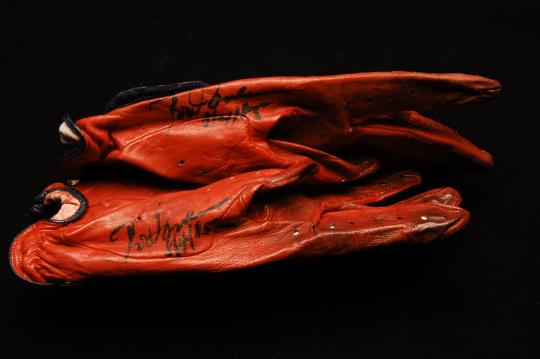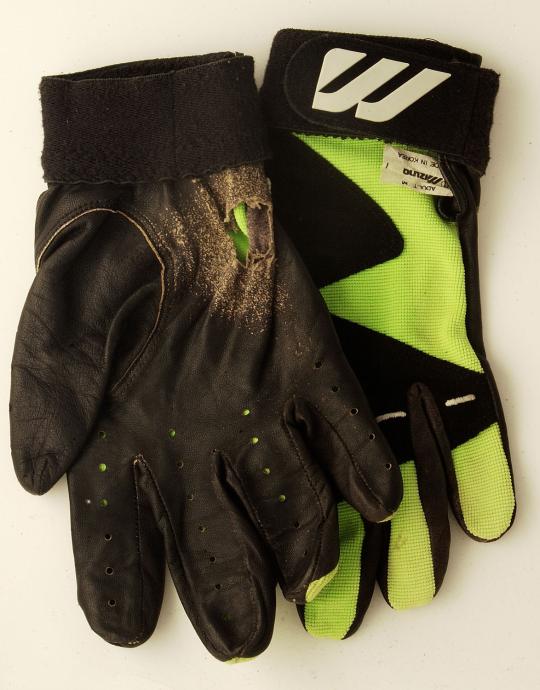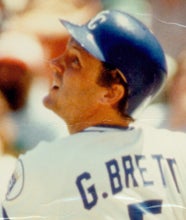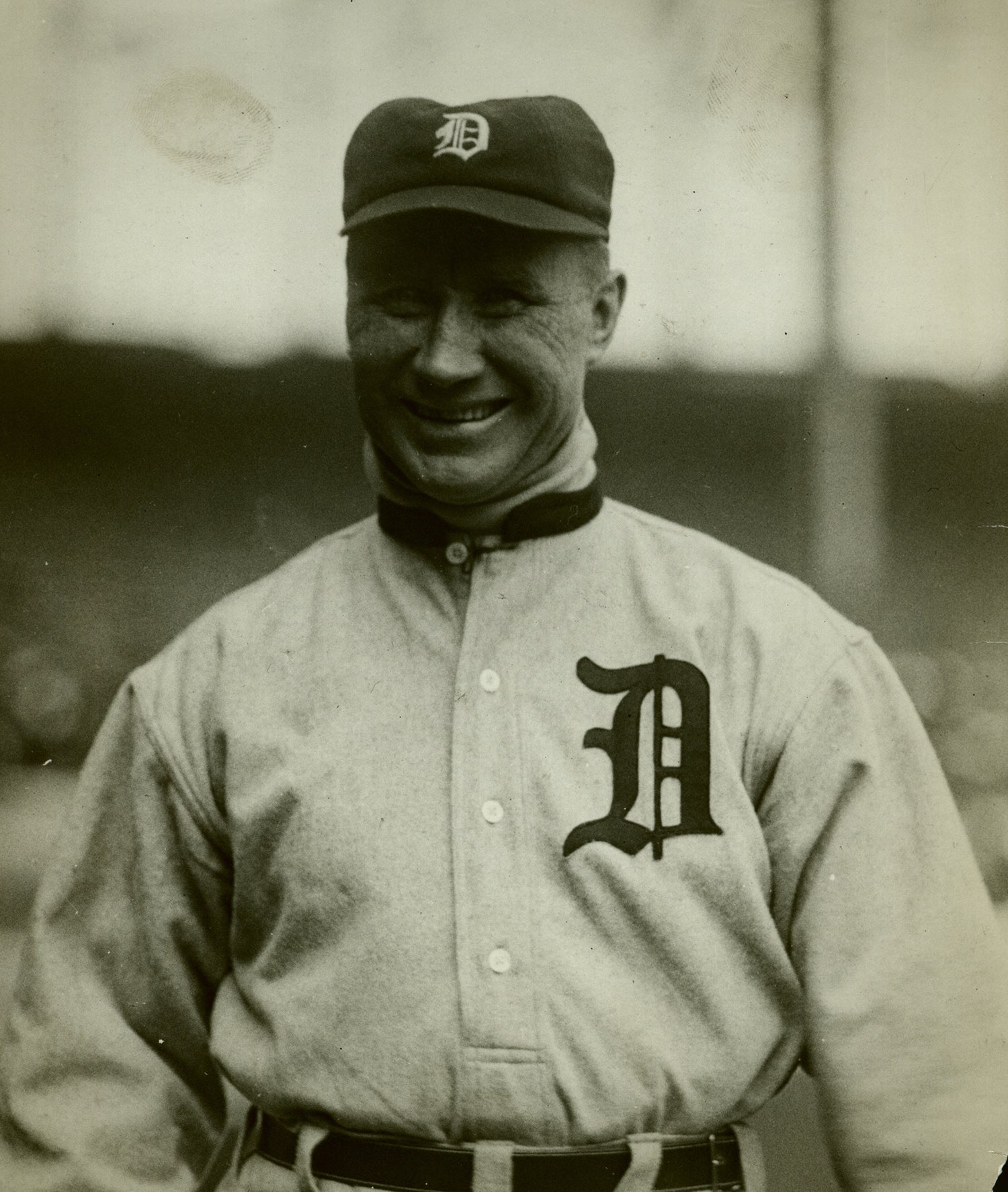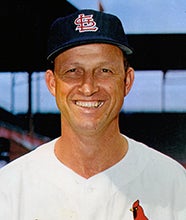“My hands are so sore I can’t hold a bat – and I wear gloves. I don’t know how the old-timers did it, before anybody used batting gloves,”
- Home
- Our Stories
- Fits Like a Glove
Fits Like a Glove
If you follow the Hall of Fame’s social media presence, you may know that Ichiro Suzuki makes frequent visits to the Museum. A reverent student of the game’s history, he often spends time looking at materials related to great hitters whose records he has surpassed.
During a 2013 visit, Ichiro studiously asked library staff if we had any articles on file which explained the history of batting gloves. We confidently replied that we did, and we’d go find them. But after a thorough search of our files, we were surprised to find that, unlike Ichiro, we were unable to produce. (Though we subsequently found a great article online written by baseball uniform guru Paul Lukas.)
Therefore, we set about doing a little research to see if we could assemble a file, and thus an article, on the history and evolution of the batting glove.
When we need to start from scratch on a research subject, we often turn to acknowledged experts in the field, with whom we have long-standing symbiotic connections such as the aforementioned Lukas. We will also often look toward two encyclopedic works on the game, Jonathan Fraser Light’s “Cultural Encyclopedia of Baseball,” and Peter Morris’ “Game of Inches: The Stories Behind the Innovations that Shaped the Game.” We also employ online databases to which the Hall subscribes, looking for early appearances of terms like “batting gloves.”
Dick Young, writing in the Sporting News in 1977, said “Most big league hitters now use one or two batting gloves to prevent palm blisters. Joe Rudi says he goes through two or three pairs a month.” This is a great find, buried deep within a notes column, which underscores one of the problems of baseball research: Often the moment of innovation goes unheralded, and nobody writes about the first guy to use batting gloves, but print references start to appear as the practice becomes widespread.
Columnists are not historians, and the nuggets of such history which find their place into such articles are often simply meant to fill out a bit of space at the end of a column. But full text search and retrieval allows us to find them in a more than random way, a great blessing to this generation of researchers. This type of searching also greatly facilitates finding much earlier references, which we sometimes can’t explain.
An 1881 reference in the Detroit Free Press tantalizes: “The Detroits put on their batting gloves yesterday and won another game.” While it would be interesting to find this statement literally true, it would be quite a surprise in an era when most fielders had not yet adopted gloves. This is perhaps a reference to cricket, which had well established batting gloves by 1890. According to a 1900 article in the Chicago Tribune, a new style of bowling (think pitching) called “roundarm” came into cricket in the mid-1820s, and “led to the introduction of batting gloves and leg guards.”
Hall of Famer Hughie Jennings may have experimented with batting gloves in 1901, according to Peter Morris, who found an article by John B. Foster: “Jennings had lots of fun flirting that big glove of his into the ball, and many and many a time he was made a present to first,” to which he was not entitled. This interesting reference so far lacks corroboration in a second source or a photograph.
Lefty O’Doul and Johnny Frederick both seem to have used some form of batting gloves in 1932, according to a brief article in the Sporting News, which described their “shock absorbers.” Both players had been injured, and both adapted with padding. Frederick wrapped his thumb with padding before each at bat, while O’Doul wore “an ordinary street glove when…facing the pitcher.” Interestingly, both players contended that “their methods are better than the ordinary sponge usually held onto the handle of the bat with strips of adhesive tape.” This quote demonstrates the tendency of baseball equipment to evolve in reaction to injuries and hazards on the playing field.
Bobby Thomson reportedly was given a pair of golf gloves by a golf pro named Danny Lawler in 1949, though Thomson is thought to have used them only for batting practice and in spring training. Intriguingly, another Bobby Thomson was using batting gloves at about the same time. A spring 1951 article in the Sporting News from Pirates camp reports on a “youthful shortstop” of that name, who played in the Sally League the previous season, hitting just .196, but driving in 71 runs. [Hall of Famer Branch] “Rickey turned him around to bat left-handed, and bought him a pair of batting gloves to wear.”
A 1965 article about A’s second baseman Dick Green led off “Batting helmets, golf gloves and extra large catcher’s mitts represent the most recent equipment innovations in baseball.” Green had jammed his thumb twice the previous season, and manager Mel McGaha suggested that a steel batting glove might be helpful in protecting Green’s digits. Rusty Staub is often cited as another early advocate, and by the late 1960s, the idea had caught on.
Ken Harrelson is often credited with bringing the batting glove into the regular season, specifically on Sept. 4, 1964, in Kansas City. Golf again was the inspiration, as Harrelson reportedly spent a long day on the links, blistering his hands, and used his red golf glove to protect them a bit in that evening’s game, in which he homered twice. Mickey Mantle bought 20 pairs of red golf gloves the next day and the Yankees took the field for pregame warm-ups wearing them and harassing Harrelson, calling him “sweetheart,” and “Mrs. Harrelson.” Even as late as the 1980s, George Brett explained his non-use of batting gloves by saying “I ain’t no sissy,” and Mel Hall of the Cleveland Indians remarked “I don’t wear gloves. Gloves are for women.” But Harrelson immediately felt the gloves gave him an edge, as he told the New York Times in 2007: “The bat felt better in my hands than it did with the gloves off.”
By 1969, frequent ads promoting batting gloves for kids appeared in baseball publications, and the following year, the Orioles included batting glove day among their annual promotions. That same year, an article reported that batting gloves “have replaced the calluses of the past.”
“My hands are so sore I can’t hold a bat – and I wear gloves. I don’t know how the old-timers did it, before anybody used batting gloves,” said Dale Berra in 1983. The Pine Tar incident that July provided a window into the use of batting gloves, as the Sporting News described Brett as “one of the few batters who doesn’t use a batting glove.” Brett reported that he liked the feel of the bat, and the pine tar “Keeps my hands from getting torn up.”
Stan Musial was asked about batting gloves in 1971, and responded that he would not have used them, as he liked to feel the bat in his hands. Even in recent years, there is a select fraternity of hitters who have stepped up to the plate unprotected. Mark Grace, Craig Counsell, Jorge Posada and others all swore by the natural feel of the bat in their hands.
Anyone who ever watched a Nomar Garciaparra at-bat knows that batting gloves can slow the game down a bit. Before Nomar, there was Mike Hargrove, whose at-bat rituals caused him to be christened “The Human Rain Delay.” Hargrove told the Sporting News in 1980 that a thumb injury caused him to pay a lot of attention to the exact fit of his batting glove: “From getting the batting glove just right, he said, “other movements followed.”
Bob Sudyk described his routine as follows: “Hargrove approaches the plate, calls time, grabs some dirt, tugs at his pants, sleeves and hitches up his waistband, adjusts his hair, taps down his helmet, squeezes his hand deeper into his batting glove, drains all moisture from his mouth and steps in after raking the dirt in the batter’s box with his cleats.”
Jeff Bagwell commented on his at-bat concentration in 1995: “I step out sometimes and go to work on my (batting) gloves, but it’s mainly a way to clear my head. It’s more of a habit than anything. I could hit without doing it, I think.”
In 1982, then minor-leaguer Ron Kittle was having trouble with bone chips in his thumb, causing him to miss playing time. In another example of how player injury drives innovation, Kittle told the papers “We’re trying to build pads in to the batting glove.” Kitttle’s idea doesn’t seem to have caught on – yet. Batting gloves are here to stay, and of course, body armor on the forearm and the batter’s front leg seems to be the next logical step in the progression of protecting players from injury.
The oldest batting glove in the Hall’s collections is one worn by Lou Brock when he got his 3,000th hit in 1979. We also have 3,000-hit gloves from Craig Biggio, Rod Carew and Derek Jeter, as well as the gloves Rickey Henderson wore when he surpassed Brock’s all-time stolen base total. We have Garciaparra’s batting gloves from his AL rookie record 30-game hitting streak in 1997.
Ichiro might be especially interested to know that we have the gloves worn by Japanese ironman Sachio Kinugasa when he played in his 2, 131st consecutive game in 1987. And we also have a pair of gloves that formerly belonged to Ichiro himself, those he used in 2004 to record hits 261 and 262, each breaking his own all-time single season hits record.
Thanks for asking, Ichiro.
Tim Wiles is the former director of research at the National Baseball Hall of Fame and Museum

